Swiss Meringue Buttercream
Find out everything you’ve ever wanted to know about Swiss Meringue Buttercream: from how it’s made and stored to what to use it for, and how to flavor it in all sorts of ways. You’ll love this light, silky frosting so much that you’ll never go back to powdered sugar again!
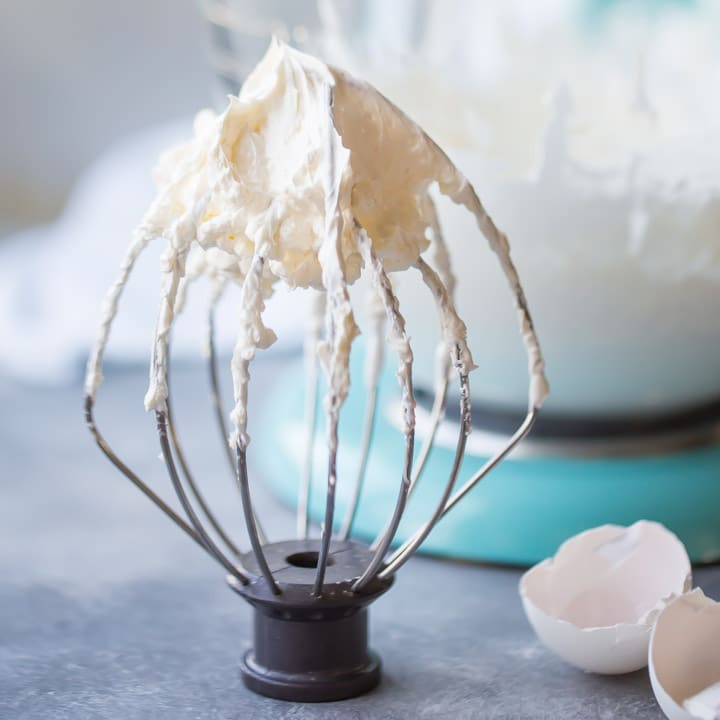
Table of Contents
- Why You’ll Love Swiss Buttercream
- Ingredients and Notes
- Specialty Equipment
- How to Make Swiss Meringue Buttercream
- Recipe FAQS
- Expert Tips
- How to Store and Keep
- How to Serve
- Is Swiss meringue buttercream stable?
- Does Swiss meringue buttercream crust over?
- Recipes that taste great with Swiss meringue buttercream:
I tried Swiss meringue buttercream for the first time about 15 years ago, and it was a total “a-ha moment!” The light, silky texture and lovely, subtle flavor blew me away. I had never tasted anything quite so delicate before.
Right away, I realized that this was the BEST way to take my cakes and cupcakes to the next level, and I have never looked back!

Why You’ll Love Swiss Buttercream
Silky Smooth Texture: This Swiss meringue buttercream recipe has an incredibly smooth and silky texture that melts in your mouth. It feels so luxurious and whisper-light.
Creamy and Rich Flavor: The combination of meringue and butter creates a rich and creamy flavor profile that is not overly sweet. It strikes a perfect balance and enhances the taste of the cake or cupcake it adorns in a beautiful way.
Versatile and Adaptable: Swiss meringue buttercream is a versatile canvas for lots of different flavors. You can easily infuse it with various extracts, such as vanilla, almond, citrus, or even floral flavors like lavender or rosewater, allowing you to truly make it your own.
Stable and Pipeable: Swiss meringue buttercream holds its shape exceptionally well, making it perfect for intricate piping designs and layer cakes. Whether you want to create delicate rosettes, elaborate borders, or intricate patterns, this buttercream will maintain its structure beautifully.
Great for Decorating: Due to its smooth texture, Swiss meringue buttercream provides an ideal base for fondant decorations. It gives a satin-y finish that’s just gorgeous, and provides a clean canvas for elaborate fondant decorations.
Not Overly Sweet: Swiss meringue buttercream is a little less sweet. The meringue helps to balance the sweetness, making it a great choice for those who prefer desserts that aren’t too sugary.
Exceptional Stability: Swiss meringue buttercream has excellent stability, which means it can withstand various temperature conditions. It holds well in warmer environments without melting or losing shape, making it a reliable choice for outdoor events.
Long Shelf Life: Swiss meringue buttercream can be stored in the refrigerator for up to a week and frozen for future use. This allows you to save time by preparing the frosting in advance.
Ingredients and Notes
Egg Whites
The egg whites help stabilize the sugar syrup and prevent it from crystallizing. When whipped at high speed until they form stiff peaks, the egg whites add a light, fluffy texture.
Granulated Sugar
The sugar is used to sweeten the buttercream and create a sugar syrup with the egg whites.
Regular white sugar is fine, or sub for another type of sweetener if you like. As long as it swaps 1:1 for granulated sugar it should work.
Butter
Softened butter is gradually added to the mixing bowl while the mixer continues to run at a medium-low speed. The butter is incorporated a few tablespoons at a time, allowing it to mix thoroughly before adding more. The meringue and butter combine to create a smooth and creamy buttercream.
I like to use unsalted butter because it lets me control the amount of salt in the dish. Different brands of butter can contain different amounts of salt, so this way you get a more consistent result.
This recipe works best if you allow the butter to come to room temperature first. You can set it out on the counter a few hours ahead of making your recipe, or you can microwave it for 10 seconds, turn it over, and microwave it again for another 8 seconds.
Salt
Salt carries the flavors and intensifies them. The result won’t taste salty, but it will make everything much more flavorful!
I like to use Kosher salt because it has no additives (table salt usually contains iodine, which can leave a bitter taste), so the flavor is pure. It’s also inexpensive and easy to find in a regular grocery store.
Specialty Equipment
Stand-Mixer
It’s easier to use a stand mixer when whipping the egg whites, but you can also use a hand mixer.
I recommend using the whisk attachment, not the paddle attachment as the whisk helps to create an airy and fluffy texture.
How to Make Swiss Meringue Buttercream
Step 1: Combine the egg whites and sugar in a large glass or metal bowl.
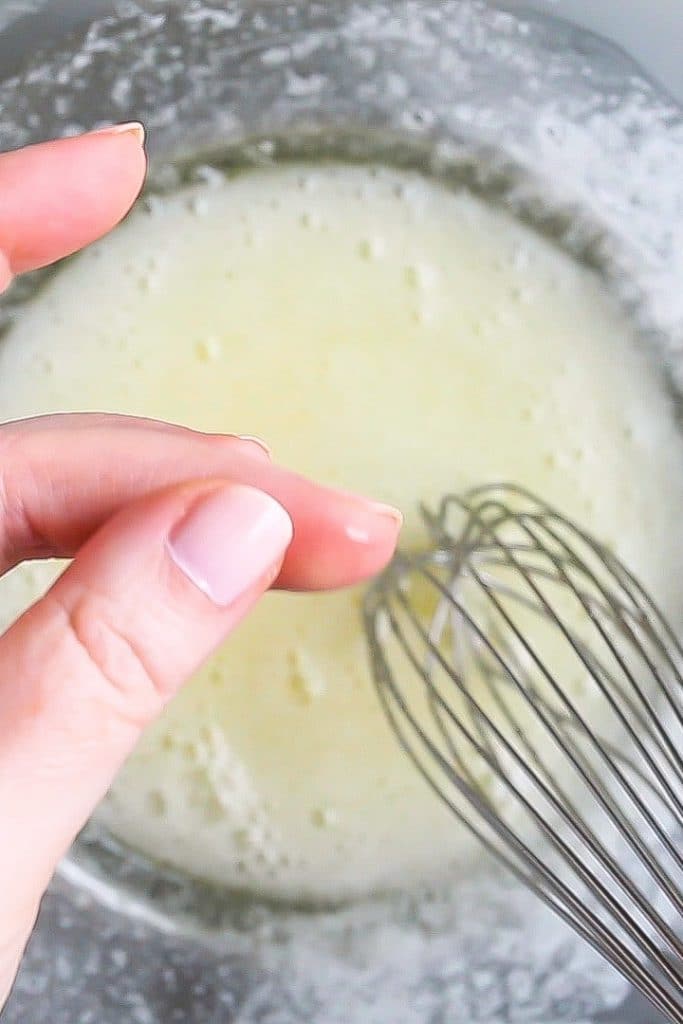
Step 2: Set the bowl over a pot of barely simmering water, and stir continuously at medium speed until the sugar is completely dissolved. (Check by rubbing a small amount between your thumb and forefinger; it should be hot to the touch and feel smooth, not gritty.)
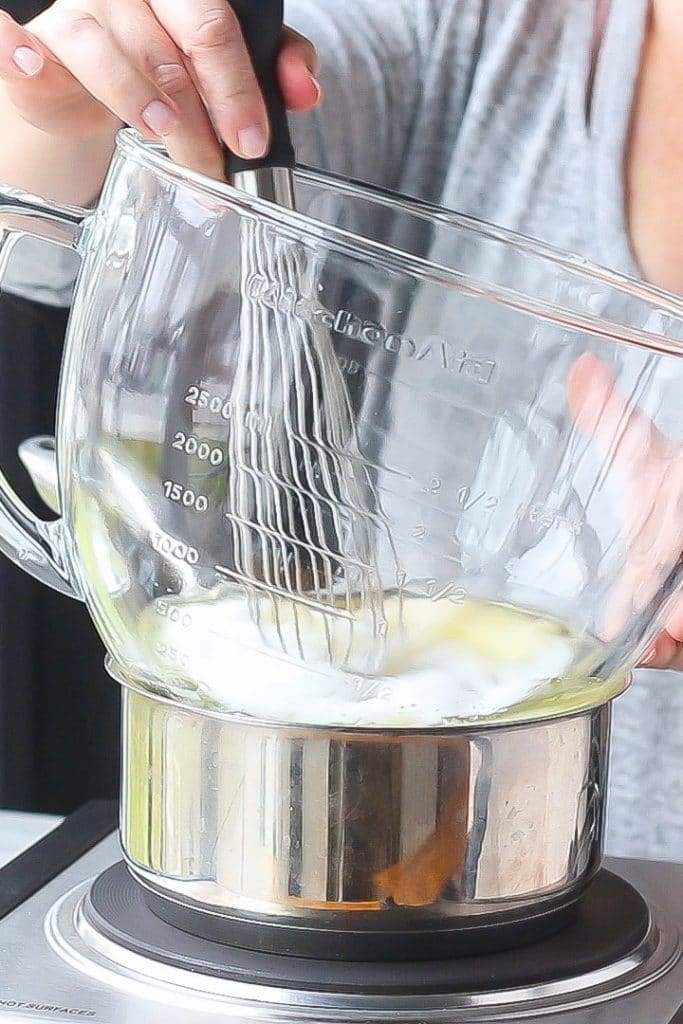
Step 3: Remove the bowl from the simmering water and whip on high speed until the meringue is thick, white, glossy, and can hold stiff peaks. (It should be cooled completely. There should be no hint of warmth when you place your hand on the side of the bowl. Refrigerate the meringue for 15 to 20 minutes if necessary.)
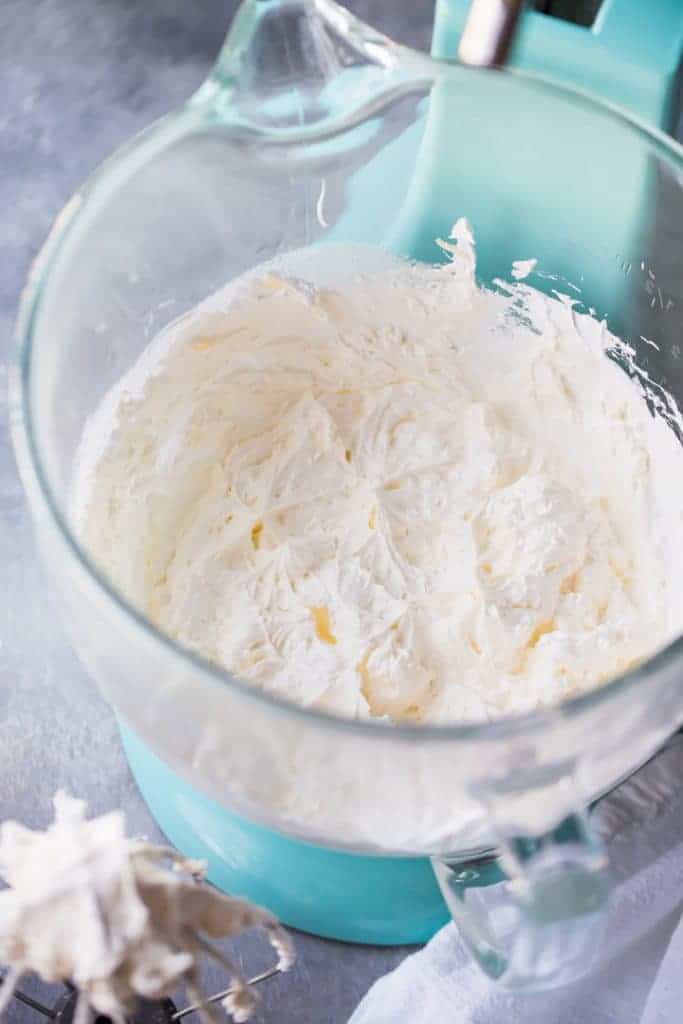
Step 4: Add the butter in a tablespoon at a time, beating well after each addition. (If the mixture looks curdled, continue to beat until it comes back together before adding the remaining butter.)
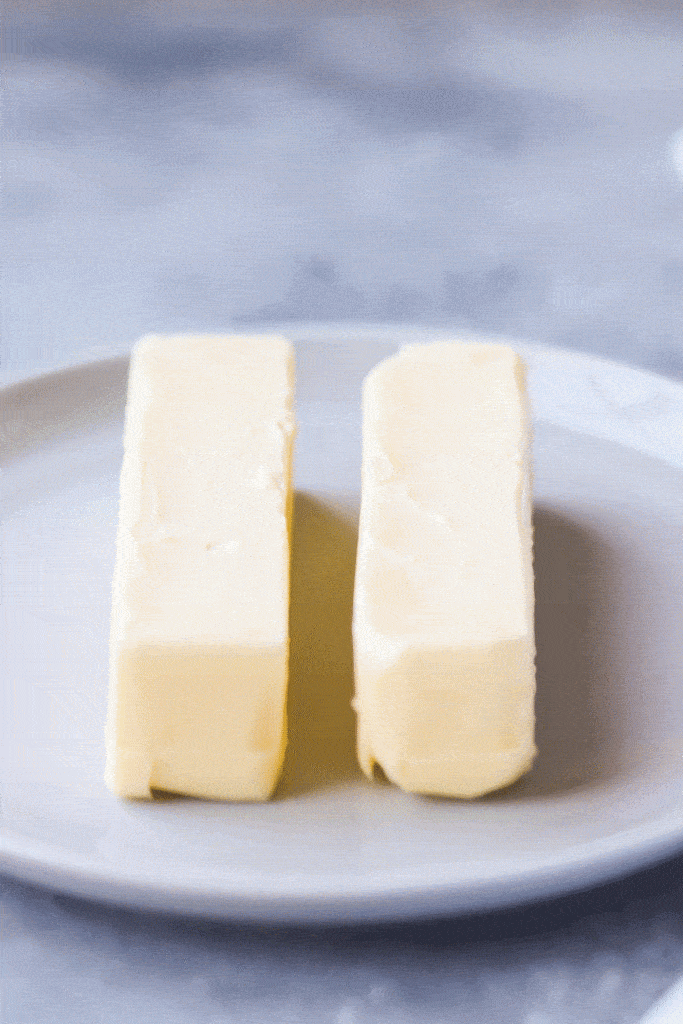
Step 5: Scrape the sides of the bowl. Fold in the salt and any other flavorings you may be using.
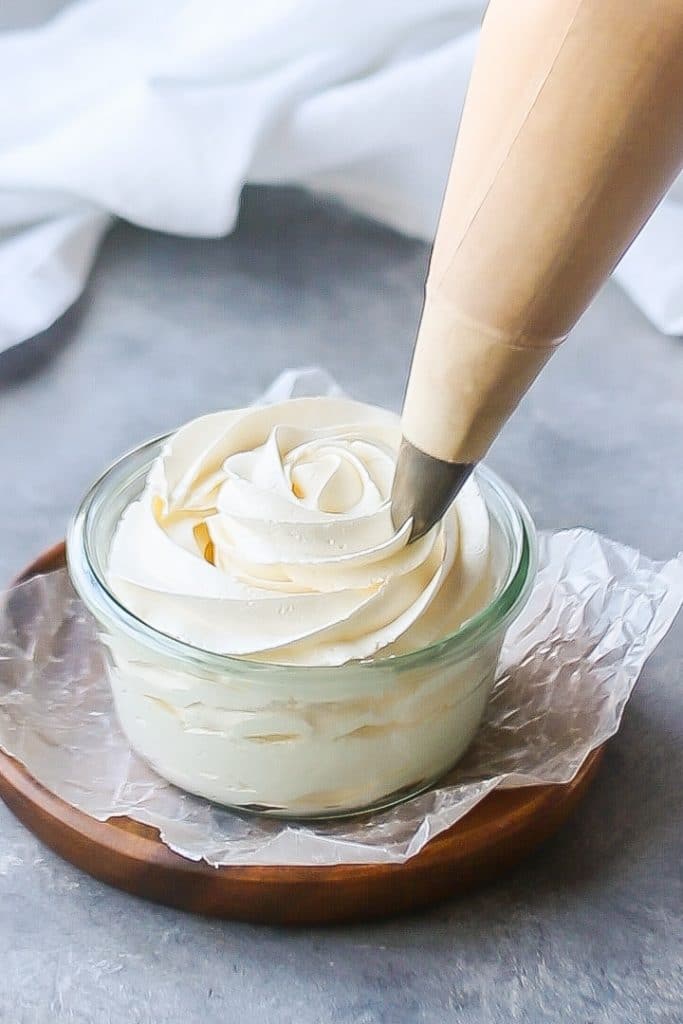
Recipe FAQS
Swiss meringue buttercream is a frosting used for topping and filling cakes, cupcakes, and macarons. It’s incredibly light and airy, yet rich and buttery at the same time. The thing that I love most about it is its silky texture. It’s made by first dissolving sugar into egg whites; it has an incredibly smooth quality that you don’t get with regular powdered sugar (aka American-style) buttercreams. When you taste it, you’ll be struck by its subtle sweetness and how it melts on your tongue.
While there is slightly more to it than just creaming butter and powdered sugar together, the payoff is huge! You’ll find that it’s worth that little bit of extra effort. And once you get the hang of it, it will seem like second nature!
The first step when making Swiss meringue buttercream is to melt sugar and egg whites together over a pot of steamy water. When the sugar is completely dissolved, you get that incredibly silky-smooth texture in your final product. But if you don’t heat the mixture long enough, you might feel gritty sugar crystals between your teeth.
Swiss meringue buttercream almost always goes through a stage that looks curdled, broken, or split. This often happens just before it entirely comes together! Just add the butter slowly (a tablespoon at a time), and let each addition fully incorporate before adding the next. Just keep on whipping, and I promise it will come back together!
Expert Tips
Avoid grainy buttercream
Cook the whites/sugar for around 10 minutes, whisking occasionally. The mixture goes from thick and transparent to thinner and more opaque.
The best way to know if the eggs and sugar are ready is to place a drop on your finger and rub it together with your thumb. If you feel any grit at all- keep cooking.
When it’s smooth, you’re ready for the next step.
You’ll also notice that the mixture feels hot to the touch. You can gauge with a candy thermometer (it should register 140 degrees F), but I don’t find that necessary. You should be good to go if it feels hot and the sugar is fully dissolved.
Avoid runny Swiss meringue buttercream
Temperature is everything when making this recipe! The whites and sugar need to get hot enough to dissolve the sugar, but they must cool way down before the butter goes in.
It’s easy to get impatient at this stage! I’ve done it plenty of times and ended up with a runny mess.
Salvage runny Swiss meringue buttercream
Put the entire thing (mixing bowl, whisk, and runny buttercream) into the fridge for about 20 minutes and re-whip. It works like magic!
It’s also a good idea to pay attention to the temperature of your butter. You want it softened, but it should still be somewhat cool. You don’t want it so slippery and nearly melted!
Use soft butter
If I soften my butter in the microwave (while still wrapped in sticks) for 10 seconds at 30% power, then flip it over and do another 8 seconds at 30% power, it comes out perfect!
Remember that all microwaves are not exactly the same, so you might have to experiment a little to find that perfect sweet spot.
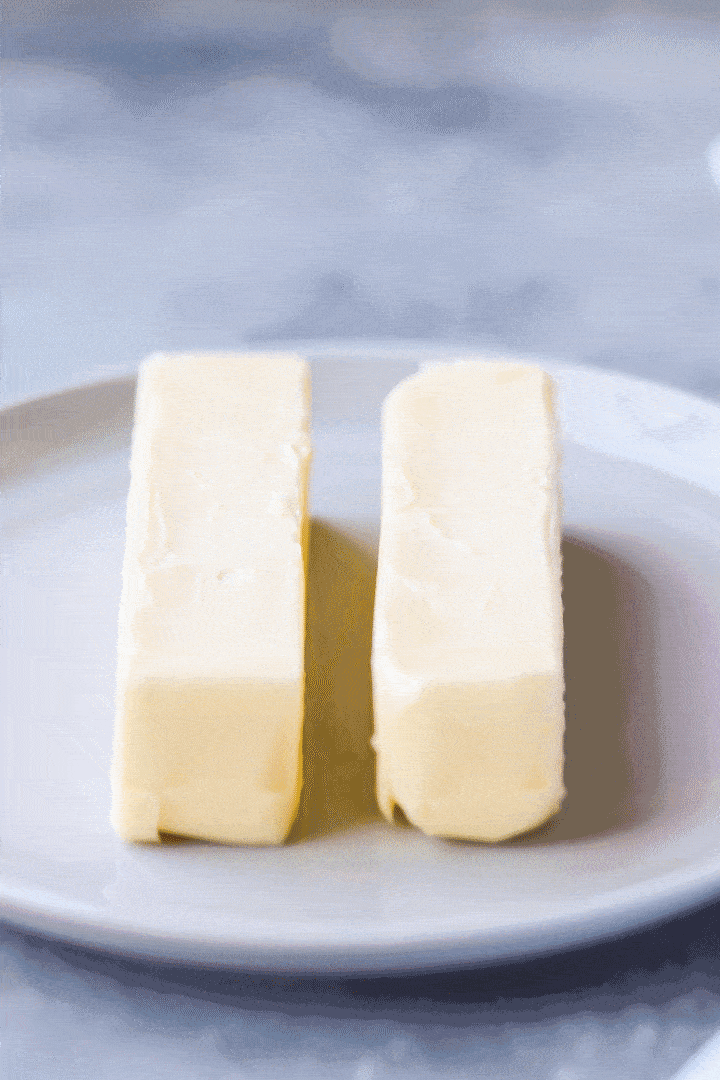
How to Store and Keep
I often make it the night before I need it and let it sit at room temperature in an airtight container. This is fine to do if you plan to use it the following day.
It can be refrigerated for up to a week if you’d like to get even further ahead of schedule. But it may come out a bit hard and lose some airy lightness.
Scoop it out of the container and re-whip it (after it returns to room temp). It will be just like new!
It can also be frozen, thawed overnight in the fridge, and follow the above method.
How to Serve
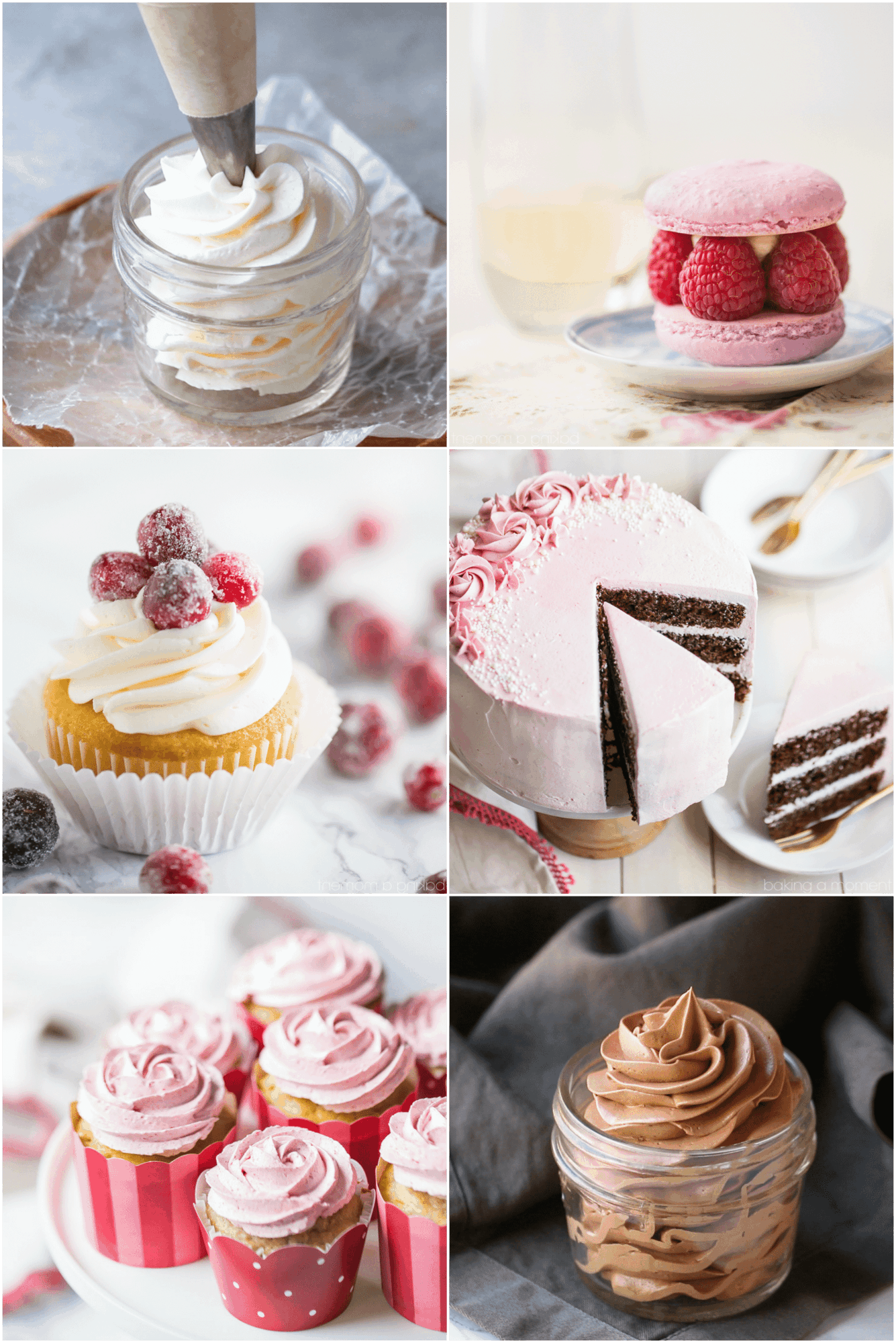
- Fold in the seeds of a vanilla bean, 1 1/2 teaspoons of vanilla bean paste, or two teaspoons of vanilla extract to make Vanilla Swiss Meringue Buttercream.
- Add melted chocolate to make Chocolate Swiss Meringue Buttercream.
- Add melted white chocolate to make White Chocolate Swiss Meringue Buttercream.
- Place freeze-dried strawberries in the food processor, grind them to a fine powder, and stir them in to make Strawberry Swiss Meringue Buttercream.
- Whip in the zest and juice of a lemon, lime, or orange for a citrus Swiss Meringue Buttercream.
- Stir a tablespoon of instant espresso powder with three tablespoons of hot water, and stir the cooled mixture to make Coffee Swiss Meringue Buttercream.
- Puree a couple of cups of raspberries, then cook them down until thickened and stir in to make Raspberry Swiss Meringue Buttercream.
- Reduce sparkling wine to a thick syrup and add it to make Champagne Swiss Meringue Buttercream.
- Swiss meringue buttercream is super versatile! It can be colored with gel paste food coloring (aka icing colors) and flavored differently.
These are just a few ideas! You’re only limited by your imagination.
Just be careful not to add too much liquid, or your buttercream could separate.
Is Swiss meringue buttercream stable?
It is the most stable buttercream out there. It works well for piping, and it holds up beautifully.
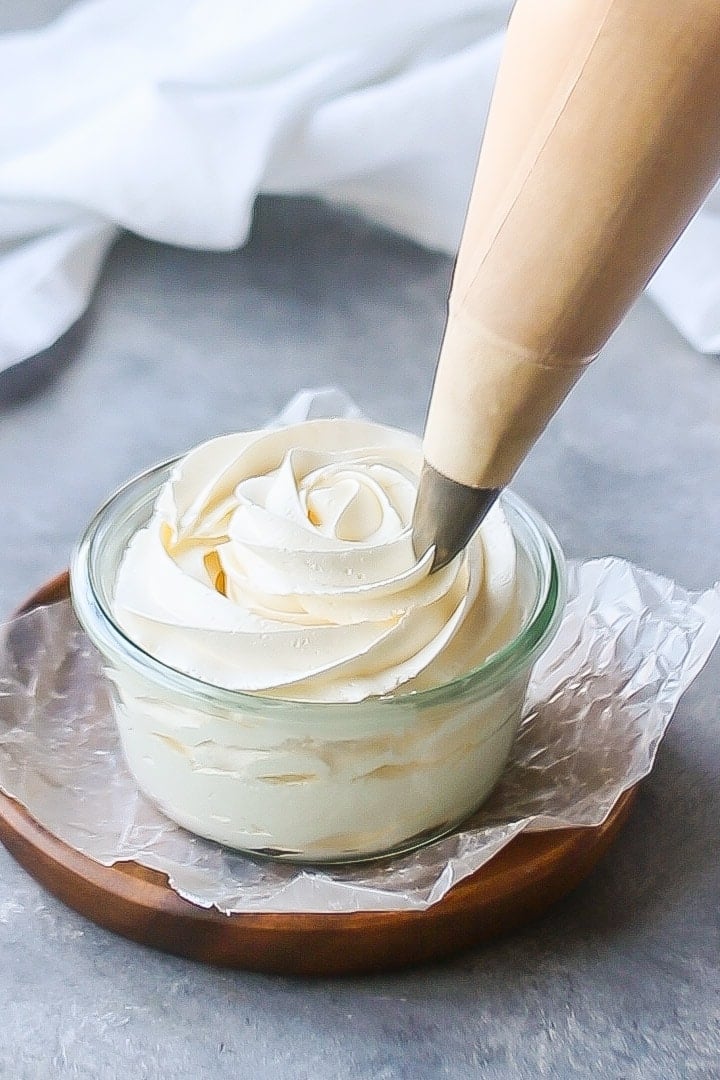
It is mostly butter, so on hot days you may have some trouble, but the egg whites do a lot to help it hold its shape. If you want to serve it on a hot day, keep your cake or cupcakes refrigerated until ready to serve.
It also works very well under fondant! It gives you a perfectly smooth surface with no lumps or bumps, so it’s really ideal. When I worked as a pastry chef, this is what we always used for fondant-topped cakes.
Does Swiss meringue buttercream crust over?
Swiss meringue buttercream will not crust as American-style buttercream does. This makes it very easy to work with, especially if you want a perfectly smooth finish on your cakes.
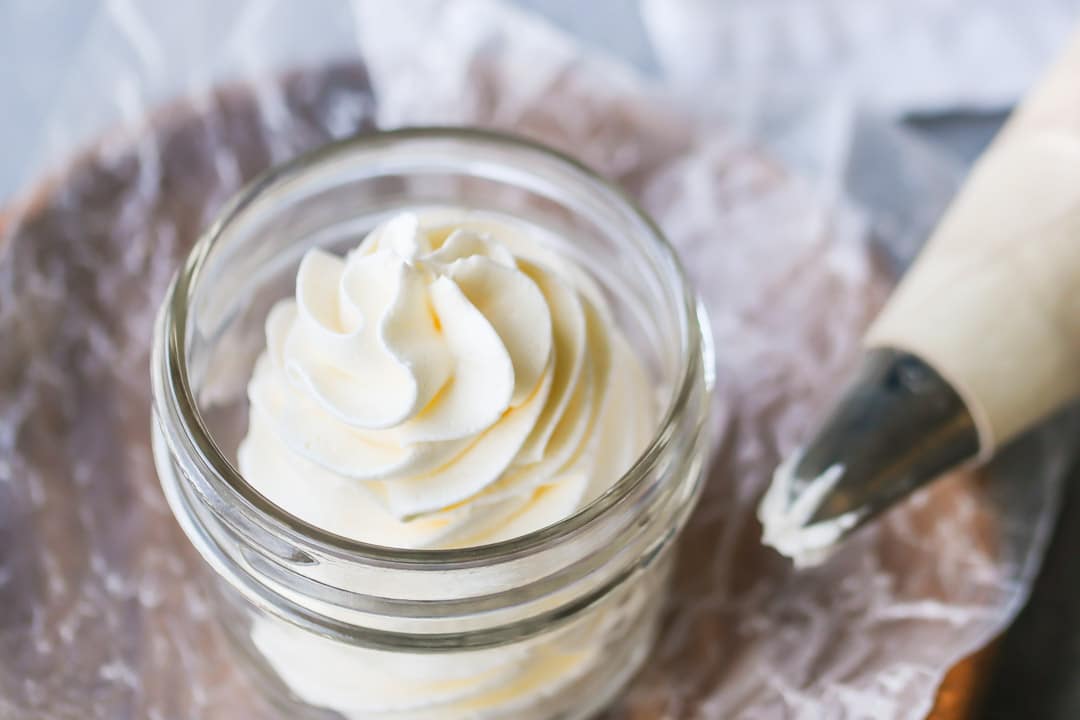
Recipes that taste great with Swiss meringue buttercream:
- Chocolate Cupcakes with Chocolate Buttercream
- Vanilla Cupcakes
- White Cupcakes
- Strawberry Cupcakes
- Butter Pecan Cupcakes
- Mango Margarita Cupcakes
- Peanut Butter Tagalong Cupcakes
- Apple Cinnamon Pancake Cupcakes with Crispy Bacon Sprinkles
- Grapefruit Champagne Mimosa Cupcakes
- Pina Colada Cupcakes
- Mocha Cupcakes
- Cranberry White Chocolate Cupcakes
- Snickers Cupcakes
- Peanut Butter & Jelly Cupcakes
- Brownie Sundae Ice Cream Cone Cupcakes
- Black & White Malt Shoppe Cupcakes
- Chocolate Cake with Raspberry Buttercream
- Salted Caramel Mocha Heaven & Hell Cake
- Vanilla Malt Layer Cake with Cashews & Salted Caramel
- Chocolate Layer Cake
- Banana Split Mini Bundt Cakes
- Neapolitan Macarons
- Shamrock Shake Macarons
- Kir Royale Macarons
- Strawberry Rose Macarons
Find more great frosting recipes on my “Icings, Frostings, Fillings, & Toppings” Pinterest board!
This post contains affiliate sales links.

Swiss Meringue Buttercream
Ingredients
- 6 large egg whites
- 2 cups (400 g) granulated sugar
- 2 cups (454 g) unsalted butter, , softened
- 1/8 teaspoon (0.13 teaspoon) kosher salt
Instructions
- In a large glass or metal bowl, combine the egg whites and sugar.
- Set the bowl over a pot of barely simmering water, and stir continuously, until the sugar is completely dissolved. (Check by rubbing a small amount between your thumb and forefinger; it should be hot to the touch, and feel smooth, not gritty.)
- Remove the bowl from the simmering water and whip on high speed until the meringue is thick, white, glossy, and can hold stiff peaks. (It should be cooled completely. There should be no hint of warmth when you place your hand on the side of the bowl. Refrigerate the meringue for 15 to 20 minutes if necessary.)
- Add the butter in, a tablespoon at a time, beating well after each addition. (If the mixture begins to look curdled, continue to beat until it comes back together, before adding the remaining butter.)
- Fold in the salt and any other flavorings you may be using.









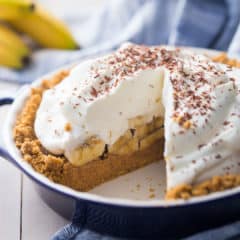

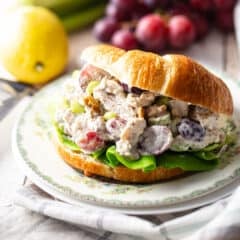
What butter do you recommend in fat content/ color / neutral taste and smell?
Hey Camila! When I test recipes, I just use regular generic butter. I want to make sure the recipe tastes delicious, even if a lower quality product is used.
Thank you for all the work you do in posting these yummy recipes! I so enjoy baking and unfortunately I love eating it as well. My body testifies to that truth! I am starting Keto this week and was wondering if you ever tried another sugar that
is Keto friendly? The egg whites and butter are fine on Keto.
Any thoughts or ideas would be helpful to me.
Thank you for your help.
I know that a lot of other readers like to use Splenda, and I myself have used a brand called Swerve. Other than that I’m not really sure- the truth is I’m not much of an expert on keto! Wishing you lots of luck!
Thanks for sharing your recipe! This and your chocolate swiss meringue buttercream are definitely my go to frostings.
This was AMAZING! Turned out perfectly for the wedding cake and cupcakes that I made. Thank you for the recipe!
Can you add cream cheese to swiss meringue to use on a red velvet cake?
I have not had much success with the attempts I’ve made.
Do you know if you can you freeze a cake frosted in SMBC and then thaw the fully frosted cake in the fridge? Or does the frosting get weird?
Hey Hannah! I have never had a problem doing that. Good luck!
can i do it without butter?
It wouldn’t be buttercream but sure.
This turned out really well as in in the fridge ready to use on Monday. Please advise how I would soften up to spread on my cake please. With normal buttercream I usually leave out if the fridge for a while to soften.
The information you’re looking for can be found under the heading “Can I Make Swiss Meringue Buttercream Ahead.”
Hello, I LOVE SMBC but I always have an issue with coloring it. I only use gel food coloring (AmeriColor mostly) but it never seems to incorporate. The color is always off and I will see tiny beads of the color that refuses to mix in. I know the gel coloring is fine since I have test it in AMBC and the color payoff is beautiful. Any tips?
Can you use salted butter and skip the 1/8t kosher salt?
Hi,
I tried your whipped cream icing with your vanilla cupcake recipe yesterday and my cupcakes turned out fabulous! I’m new to baking and wanted to try this icing so stupid question but how many stick of butter is 2cups? Thank you! I can’t wait to try it!
Hey there! So glad you were happy with the cupcakes! One stick of butter is equal to 1/2 cup. It will say that right on the wrapper. So 2 cups of butter would be 4 sticks. Good luck!
Can you swap out half the butter for cream cheese to make a cream cheese frosting?
I have not had much luck with that, sorry!
Could I do a thick layer under a fondant or will it deform and not hold up?
Hello
I have been doing a lot of searching for the best swiss meringue buttercream. I recently saw a recipe using your exact measurements and ingredients except for the amount of egg whites. That recipe called for 9 egg whites instead of 6. Can you tell me if adding more or less egg whites makes a difference in the taste or texture.
Good Day!!! Thanks for the recipe but i got a problem in adding the food color in tge buttercream since i dont have gel type food color so i used the ordinary liquid food color, so how to i add so that my meringue will not be runny and i want to be intense color..?
I would not suggest using liquid food coloring, too much will definitely make your buttercream runny! So sorry about that!
Hi
I’ve made Swiss meringue from a different recipe and it turned out tasting like creamed butter, is there anything I can do about that?
I can’t really say without seeing the recipe you used.
The original recipe was 5 eggs 1 cup sugar a pinch of salt and four sticks of butter, so far though it’s the only recipe I’ve tried that has worked out every other recipe has gone soupy.